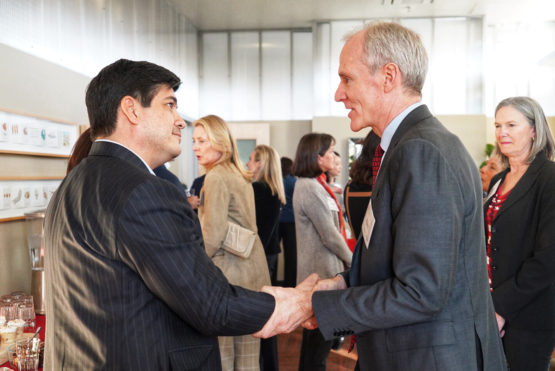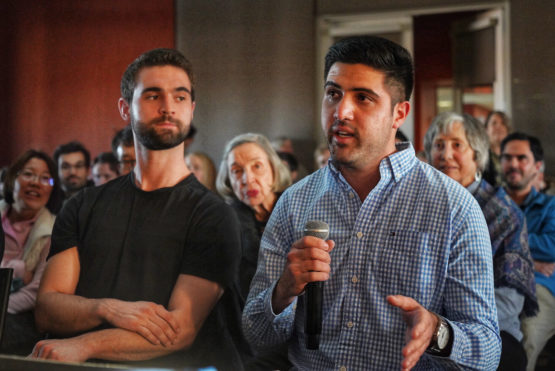Carlos Alvarado Quesada, president of Costa Rica, visited Stanford to present his plan for national decarbonization
The president described a vision for his country to become an ethical example to the global community. He also spoke with Stanford researchers directing conservation and sustainable development initiatives in Costa Rica.
A long-time global leader in conservation, Costa Rica now has bold plans to play the same role for renewable energy. In a speech at Stanford University on March 13, Costa Rican President Carlos Alvarado Quesada outlined the Central American country’s goal of phasing out all carbon emissions by the year 2050.

Stanford President Marc Tessier-Lavigne greets President Alvarado in a pre-event reception. (Image credit: Don Feria)
Alvarado described a vision for his country as a “decarbonization lab,” a living example for the global community. Reaching that goal, he said, will require passion, duty and an ethical commitment to creating lasting environmental change. Alvarado likened the reality of climate change to other historical moments in the country’s past, including the equal rights movement and the abolition of the military, and emphasized the courage it took for previous generations to pioneer such change.
“We are the heirs of a beautiful tradition of innovation and change,” Alvarado said. “That’s why we’re doing this: not because it’s fashionable, but because it’s an ethical responsibility … it’s not an option, it’s a must.”
Costa Rica is well-known for its progressive conservation initiatives designed to prevent deforestation and preserve the region’s ecological treasures. Examples include early adoption of payments for environmental services programs and the development of a booming ecotourism industry centered on the region’s wealth of biodiversity. The country currently runs on 99.5 percent clean and renewable energy production – infrastructure that can be used as a stepping stone towards decarbonization.
Gretchen Daily, founder and faculty director of the Stanford Natural Capital Project, and Chris Field, director of the Stanford Woods Institute for the Environment, joined Alvarado in an onstage conversation after his remarks.
Both organizations have ongoing research in Costa Rica. Woods coordinates a community-focused conservation initiative in Costa Rica that reconciles perceived conflicts between human prosperity and protection of natural resources. The Natural Capital Project is using its integrated software and science approach to help the country’s central bank and ministry for environment and energy understand and properly value the diverse benefits that nature provides to people. By applying this natural capital-based perspective, the ministries are able to better incorporate conservation initiatives into policy and finance decisions.

Costa Rican native Amir Fassihnia Dengo, MS, civil engineering ’20, asks President Alvarado a question about the role of governance in creating change. (Image credit: Don Feria)
As part of the Natural Capital Project’s work in Costa Rica, Stanford researchers are linking earth observations and biodiversity monitoring to biodiversity’s value for human health and well-being. Connecting these three areas of science is a research first, and the abundance of ecological data and biodiversity in Costa Rica create an ideal testing ground. NASA, which funds the effort, ultimately plans to expand the pilot globally so that other countries can meet their biodiversity plans and sustainable development goals –complimenting Alvarado’s goal of Costa Rica serving as a living lab.
“As a Costa Rican citizen, it’s a little weird for me to ask my President a question in English,” said Amir Fassihnia Dengo, MS, civil engineering ’20, garnering a laugh from the crowd before leading into his question about the role of governance, policy, and Costa Rica’s state-owned monopolies.
The president acknowledged that the path to decarbonization will require critical analysis of the current governmental systems in place, including state-owned monopolies on energy and oil. While he said all of the implementation details of the decarbonization plan have yet to be determined, the president was resolute about moving forward. “The best plan is a flexible plan,” he said, “we haven’t figured out all the details yet, but we need to make the first step.”
Others can join Costa Rica in that journey, Alvarado said. “We have the science, we have the technology; you know that at Stanford better than anyone.”
To read all stories about Stanford science, subscribe to the biweekly Stanford Science Digest.
Daily is also the Bing Professor in Environmental Science and a senior fellow at the Stanford Woods Institute for the Environment. Field is also the Melvin and Joan Lane Professor for Interdisciplinary Environmental Studies, a professor of biology and of Earth system science; and a senior fellow at the Precourt Institute for Energy.
Go to the web site to view the video.
